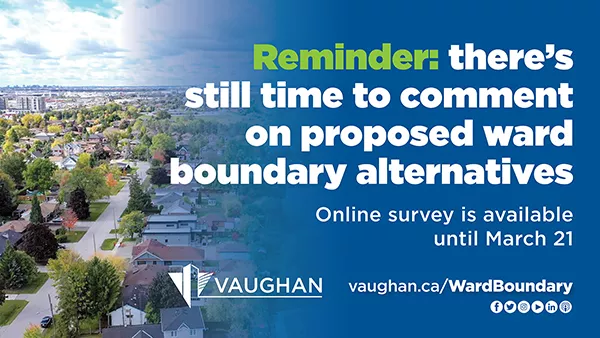Online survey is available until March 21
There’s still time to get involved in the City of Vaughan’s Ward Boundary Review. Available until Sunday, March 21, complete the online survey at vaughan.ca/WardBoundary to explore key findings, comment on options, rank maps and more.
The objective of the Ward Boundary Review is to assess whether Vaughan’s present wards are continuing to provide effective, equitable and democratic representation. Public input is a vital part of this project. At this stage of the process, citizens are invited to review potential alternative ward boundary structures, comment on maps, rank the proposed options, indicate preferences and provide feedback.
Initial research and public feedback collected from virtual public open houses hosted in January 2021 have helped inform the study and contributed to various aspects, maps and alternatives being proposed. Additional virtual public open houses were also held earlier this week for citizens to provide comment on the proposed options presented. All feedback gathered – including from this current survey – will be compared to current population trends and legal precedence. A summary report will be sent to Council in May 2021. In June, Council will review and determine whether to adjust, divide, dissolve or maintain the City’s existing ward boundaries. If changes are required, confirmation will be made well ahead of the municipal election in 2022.
Why is the City reviewing the ward boundaries?
Over the last decade, Vaughan’s population has grown by more than 28 per cent. However, the growth has not been uniform across the city and has resulted in population disparity among the five wards. With this Ward Boundary Review, the City is moving forward with its long-standing commitment to ensuring all areas of the municipality are represented fairly, accurately and democratically so citizens’ voices and needs are reflected in Council decision-making. This review is limited to consideration of the five ward boundaries, not the Mayor or Regional Councillors.
In completing the review, the suitability of the present or proposed wards will be evaluated using the following guiding principles, all in accordance with the Direction for Ward Boundary and Council Composition Review presented to Council in May 2020:
- representation by population
- consideration of current and future population trends
- consideration of physical and natural boundaries
- consideration of communities of interest
- effective representation
Effective representation has become an integral part of the evaluation of electoral systems in Canada. It will serve as an evaluation and will address questions such as:
- Are the individual wards proposed reasonable and clear units of representation?
- Do they provide equitable access to Councillors for residents of the municipality?
- Are the proposed wards of a size, scale and shape that a Councillor can serve constituents successfully?
- Do the wards constitute a system that can be judged to deliver effective representation even if some specific principles are only partially successful?
Although the municipality began with all Members of Vaughan Council elected at-large, a ward system – a geographical division of a city or town for administrative and political purposes – was established in 1985. The configuration was modified in an Ontario Municipal Board, now known as the Local Planning Appeal Tribunal, order in 1994 from three wards electing a total of five Councillors to five wards, each electing one Councillor. Vaughan’s current representation system consists of a nine-member Council, composed of the Mayor as the Head of Council, three Local and Regional Councillors (elected at-large) and five City Councillors (each representing one ward). Based on a decision made by York Regional Council (PDF), Vaughan will elect a fourth Regional Councillor in the 2022 municipal election. Some minor boundary changes were approved before the 2000 and 2006 municipal elections, however, Vaughan’s current five wards have been in place without significant change since 2009. In 2016, an independent boundary review brought an alternative configuration to Council, but it was not adopted.
The Ward Boundary Review supports the City of Vaughan’s 2018-2022 Term of Council Service Excellence Strategic Plan priority of governance and fiscal responsibility through commitment to holding the public’s trust with inclusive, transparent and accountable decision-making, responsible financial management, superior service delivery, and effective communication.
-30-

